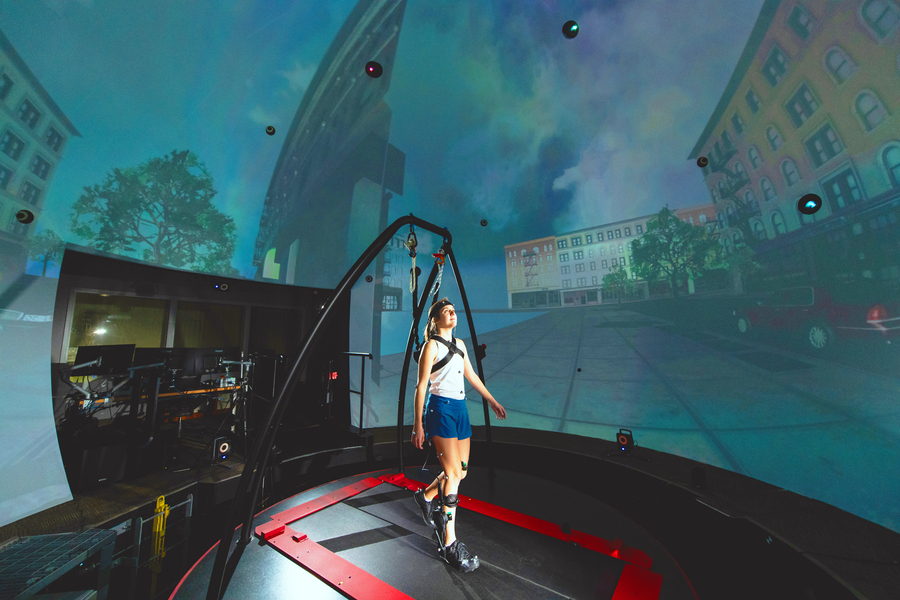MIT Lincoln Laboratory has established a new research and development division, the Biotechnology and Human Systems Division. The division will address emerging threats to both national security and humanity. Research and development will encompass advanced technologies and systems for improving chemical and biological defense, human health and performance, and global resilience to climate change, conflict, and disasters.
“We strongly believe that research and development in biology, biomedical systems, biological defense, and human systems is a critically important part of national and global security. The new division will focus on improving human conditions on many fronts," says Eric Evans, Lincoln Laboratory director.
The new division unifies four research groups: Humanitarian Assistance and Disaster Relief (HADR) Systems, Counter-Weapons of Mass Destruction Systems, Biological and Chemical Technologies, and Human Health and Performance Systems.
"We are in a historic moment in the country, and it is a historic moment for Lincoln Laboratory to create a new division. The nation and laboratory are faced with several growing security threats, and there is a pressing need to focus our research and development efforts to address these challenges," says Edward Wack, who is head of the division.
The laboratory began its initial work in biotechnology in 1995, through several programs that leveraged expertise in sensors and signal processing for chemical and biological defense systems. Work has since grown to include prototyping systems for protecting high-value facilities and transportation systems, architecting integrated early-warning biodefense systems for the U.S. Department of Defense (DoD), and applying artificial intelligence and synthetic biology technologies to accelerate the development of new drugs. In recent years, synthetic biology programs have expanded to include complex metabolic engineering for the production of novel materials and therapeutic molecules.
“The ability to leverage the laboratory’s deep technical expertise to solve today’s challenges has long laid the foundation for the new division,” says Christina Rudzinski, who is an assistant head of the division and formerly led the Counter-Weapons of Mass Destruction Systems Group.
In recent years, the laboratory has also been growing its work for improving the health and performance of service members, veterans, and civilians. Laboratory researchers have applied decades of expertise in human language technology to understand disorders and injuries of the brain. Other programs have used physiological signals captured with wearable devices to detect heat strain, injury, and infection. The laboratory’s AI and robotics expertise has been leveraged to create prototypes of semi-autonomous medical interventions to help medics save lives on the battlefield and in disaster environments.
The laboratory's transition to disaster response technology extends over the past decade. Its rich history developing sensors and decision-support software translated well to the area of emergency response, leading to the development in 2010 of an emergency communications platform now in use worldwide, and the deployment of its advanced laser detection and ranging imaging system to quickly assess earthquake damage in Haiti. In 2015, the HADR Systems Group was established to build on this work.
Today, the group develops novel sensors, communication tools, and decision-support systems to aid national and global responses to disasters and humanitarian crises. Last year, the group launched its climate change initiative to develop new programs to monitor, predict, and address current and future climate change impacts.
Through these initiatives, the laboratory has come to view its work not only in the context of national security, but also global security.
"Pandemics and climate change can cause instability, and that instability can breed conflict,” says Wack. "It benefits the United States to have a stable world. To the degree that we can, mitigating future pandemics and reducing the impacts of climate change would improve global stability and national security."
In anticipation of the growing importance of these global security issues, the laboratory has been significantly increasing program development, strategic hiring, and investment in biotechnology and human systems research over the past few years. Now, that strategic planning and investment in biotechnology research has come to fruition.
One of the division's initial goals is to continue to build relationships with MIT partners, including the Department of Biological Engineering, the Institute for Medical Engineering and Science, and the McGovern Institute for Brain Research, as well as Harvard University and local hospitals such as Massachusetts General Hospital. These collaborators have helped bring the laboratory's sensor technology and algorithms to clinical applications for Covid-19 diagnostics, lung and liver disorders, bone injury, and spinal surgical tools. “We can have a bigger impact by drawing on some of the great expertise on campus and in our Boston medical ecosystem,” says Wack.
Another goal is to lead the nation in research surrounding the intersection of AI and biology. This research includes developing advanced AI algorithms for analyzing multimodal biological data, prototyping intelligent autonomous systems, and making AI-enabled biotechnology that is ethical and transparent.
“Because of our extensive experience supporting the DoD, the laboratory is in a unique position to translate this cutting-edge research, including that from the commercial sector, into a government and national security context,” says Bill Streilein, principal staff in the Biotechnology and Human System Division. “This means not only addressing typical AI application issues of data collection and curation, model selection and training, and human-machine teaming, but also issues related to traceability, explainability, and fairness.”
Leadership also sees this new division as an opportunity to continue to shape an innovative, diverse, and inclusive culture at the laboratory. They will be emphasizing the importance of an interdisciplinary approach to solving the complex research challenges the division faces.
“We want help from the rest of the laboratory,” says Jeffrey Palmer, an assistant head of the division who previously led the Human Health and Performance Systems Group. “I think there are many ways that we can help other divisions in their missions, and we absolutely need them for success in ours. These challenges are too big to face without applying the combined capabilities of the entire laboratory.”
The Biotechnology and Human Systems Division joins Lincoln Laboratory's eight other divisions: Advanced Technology; Air, Missile, and Maritime Defense Technology; Communication Systems; Cyber Security and Information Sciences; Engineering; Homeland Protection and Air Traffic Control; ISR and Tactical Systems; and Space Systems and Technology. Lincoln Laboratory is a federally funded research and development center.










